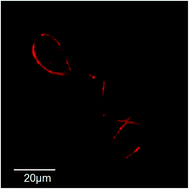pH luminescence switching, dihydrogen phosphate sensing, and cellular uptake of a heterobimetallic ruthenium(ii)–rhenium(i) complex†
Abstract
A new heterobimetallic ruthenium(II)–rhenium(I) complex of [Ru(bpy)2(HL)Re(CO)3Cl](ClO4)2·6H2O (RuHLRe) {bpy = 2,2′-bipyridine and HL = 2-(4-(2,6-di(pyridin-2-yl)pyridin-4-yl)phenyl)-1H-imidazo[4,5-f][1,10]phenanthroline} was synthesised and characterised by elemental analysis, proton nuclear magnetic resonance spectroscopy, and mass spectrometry. The ground- and excited-state acid–base properties of RuHLRe were studied using UV–Vis absorption spectrophotometric and spectrofluorimetric titrations in a 100 : 1 (v/v) Britton–Robinson buffer–CH3CN solution combined with luminescence lifetime measurements. The complex exhibited two-step separate protonation–deprotonation processes in both the ground and excited states. The complex acted as pH-induced “off–on–off” luminescence switches (Ion/Ioff = 31.0 and 14.6), with one of the switching actions being driven by pH variations over the physiological pH range (5.3–8.0). Importantly, cellular imaging and cytotoxicity experiments demonstrated that RuHLRe rapidly and selectively illuminated the membrane of HeLa cells over fixed cells and exhibited reduced cytotoxicity at the imaging concentration compared to the Re(I)-free parent Ru(II) complex. In addition, RuHLRe acted as an efficient “turn on” emission sensor for H2PO4− and “turn off” emission sensor for F− and OAc−.


 Please wait while we load your content...
Please wait while we load your content...